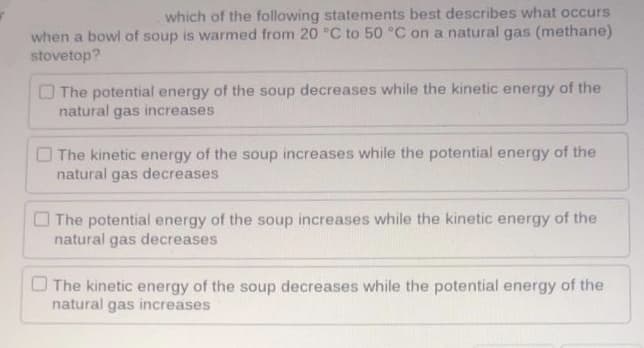which of the following statements best describes what occurs when a bowl of soup is warmed from 20 °C to 50 °C on a natural gas (methane) stovetop? O The potential energy of the soup decreases while the kinetic energy of the natural gas increases O The kinetic energy of the soup increases while the potential energy of the natural gas decreases O The potential energy of the soup increases while the kinetic energy of the natural gas decreases O The kinetic energy of the soup decreases while the potential energy of the natural gas increases
which of the following statements best describes what occurs when a bowl of soup is warmed from 20 °C to 50 °C on a natural gas (methane) stovetop? O The potential energy of the soup decreases while the kinetic energy of the natural gas increases O The kinetic energy of the soup increases while the potential energy of the natural gas decreases O The potential energy of the soup increases while the kinetic energy of the natural gas decreases O The kinetic energy of the soup decreases while the potential energy of the natural gas increases
Chemistry: An Atoms First Approach
2nd Edition
ISBN:9781305079243
Author:Steven S. Zumdahl, Susan A. Zumdahl
Publisher:Steven S. Zumdahl, Susan A. Zumdahl
Chapter7: Chemical Energy
Section: Chapter Questions
Problem 100AE
Related questions
Question
Give the correct option and explanation also!

Transcribed Image Text:which of the following statements best describes what occurs
when a bowl of soup is warmed from 20 °C to 50 °C on a natural gas (methane)
stovetop?
O The potential energy of the soup decreases while the kinetic energy of the
natural gas increases
O The kinetic energy of the soup increases while the potential energy of the
natural gas decreases
O The potential energy of the soup increases while the kinetic energy of the
natural gas decreases
O The kinetic energy of the soup decreases while the potential energy of the
natural gas increases
Expert Solution
This question has been solved!
Explore an expertly crafted, step-by-step solution for a thorough understanding of key concepts.
Step by step
Solved in 2 steps

Knowledge Booster
Learn more about
Need a deep-dive on the concept behind this application? Look no further. Learn more about this topic, chemistry and related others by exploring similar questions and additional content below.Recommended textbooks for you

Chemistry: An Atoms First Approach
Chemistry
ISBN:
9781305079243
Author:
Steven S. Zumdahl, Susan A. Zumdahl
Publisher:
Cengage Learning

Chemistry
Chemistry
ISBN:
9781305957404
Author:
Steven S. Zumdahl, Susan A. Zumdahl, Donald J. DeCoste
Publisher:
Cengage Learning

Chemistry: Principles and Practice
Chemistry
ISBN:
9780534420123
Author:
Daniel L. Reger, Scott R. Goode, David W. Ball, Edward Mercer
Publisher:
Cengage Learning

Chemistry: An Atoms First Approach
Chemistry
ISBN:
9781305079243
Author:
Steven S. Zumdahl, Susan A. Zumdahl
Publisher:
Cengage Learning

Chemistry
Chemistry
ISBN:
9781305957404
Author:
Steven S. Zumdahl, Susan A. Zumdahl, Donald J. DeCoste
Publisher:
Cengage Learning

Chemistry: Principles and Practice
Chemistry
ISBN:
9780534420123
Author:
Daniel L. Reger, Scott R. Goode, David W. Ball, Edward Mercer
Publisher:
Cengage Learning

Chemistry & Chemical Reactivity
Chemistry
ISBN:
9781337399074
Author:
John C. Kotz, Paul M. Treichel, John Townsend, David Treichel
Publisher:
Cengage Learning

Chemistry by OpenStax (2015-05-04)
Chemistry
ISBN:
9781938168390
Author:
Klaus Theopold, Richard H Langley, Paul Flowers, William R. Robinson, Mark Blaser
Publisher:
OpenStax

Chemistry & Chemical Reactivity
Chemistry
ISBN:
9781133949640
Author:
John C. Kotz, Paul M. Treichel, John Townsend, David Treichel
Publisher:
Cengage Learning